Welcome back to our column showcasing the art and artists inspired by Twin Peaks, and in some cases other Lynch works. This time we talk to one of our own, Gisela Fleischer (also known as Garmonbozia) who aside from writing illuminating articles here on 25YL, has released numerous Season 3 reaction videos on her Youtube channel, produces music, art, and photography, and for a whole year took a photo of herself in a totally different guise for the 365 Masquerades project.
25YL: Can you tell me about your first experience with Twin Peaks and if that led to interest in Lynch, or if you had already seen some Lynch before that.
GF: Twin Peaks first aired in Sweden on one of the two public service channels in late 1990. Back then, not only was I just nine years old, but I also spent almost every night rehearsing A Christmas Carol by Charles Dickens (my first theater performance with a total of 260 amateur actors). Some years later, the show aired again on other Swedish channels, none of which I had access too. I believe I was 14 or 15 years old when I learned about the existence of Twin Peaks for the first time. I remember clearly that as I heard my friends describe it as a TV series, I immediately thought of Dallas, Falcon Crest, and other soap operas. For me, the genres were pretty much the same. I think it’s good to know that I grew up during the exact time when Sweden had only two, later three, and later still, four channels to choose from—something that wasn’t a problem, but it meant that I wasn’t exactly used to the concept or format of an ongoing series.
Eventually I must have been convinced by my cable TV friends, somehow, that Twin Peaks was different, even great. One evening soon after I attended a rental movie night at a friend’s house and we all saw Fire Walk With Me. Yes, that’s right: I saw Fire Walk With Me. I knew how Laura died before I saw the series. I’ve thought a lot about this during the years. How amazing it would have been to see the series first, without spoilers. How would I have reacted? On the other hand, Fire Walk With Me drew me in pretty hard. It entangled me. Completely captured me. I didn’t understand all of the contexts of course, but I can’t remember being at all bothered by it. I was just completely amazed. I loved this mysterious and frightening, yet unbelievably beautiful thing that I was watching and hearing. I wanted more. With no internet, and living in a country where every US movie was always released much later, all I could find was what I thought was this other Twin Peaks movie. Later, I understood that this was actually the Pilot episode with the so called “international ending” or “European version”. Anyone who’ve seen this version of the pilot recognizes that it contains material not included in the pilot that is now seen as the start of Twin Peaks Season 1. Some of those parts are later included in Cooper’s dream, but not all of it. The pilot version that I saw is pretty much still one of my Twin Peaks favorites. The scenes with BOB in the basement are amazing.
So that is how I got introduced to Twin Peaks. The mystery was spoiled for me from the get go, and that’s unfortunate. However, I somehow think that the fact I saw Fire Walk With Me first, and then the European/international Pilot, made me fall instantly in love with the darker, enigmatic and supernatural part of Twin Peaks that is extra present in those two. That, I’m thankful for.
I then continued on wanting to see everything from the beginning, of course. Someone I knew had the first two seasons on VHS, and I remember borrowing two large tote bags full of VHS tapes that I carefully carried (with discomfort) back to where I lived. The video quality was terrible because the VHS tapes had probably been copied and recopied about a million times. The audio, the colors and sharpness were pretty bad, but I don’t remember me being too bothered—I was just so into the story when I was watching it. To this day, I’m still just as amazed and captured by Twin Peaks as I was back then. No, actually, I think I’m even more so now, but in that way you’re still fascinated and obsessed with something that you’ve seen literally 22 times or more now. Twin Peaks only tends to continue to grow on me, as it seems.
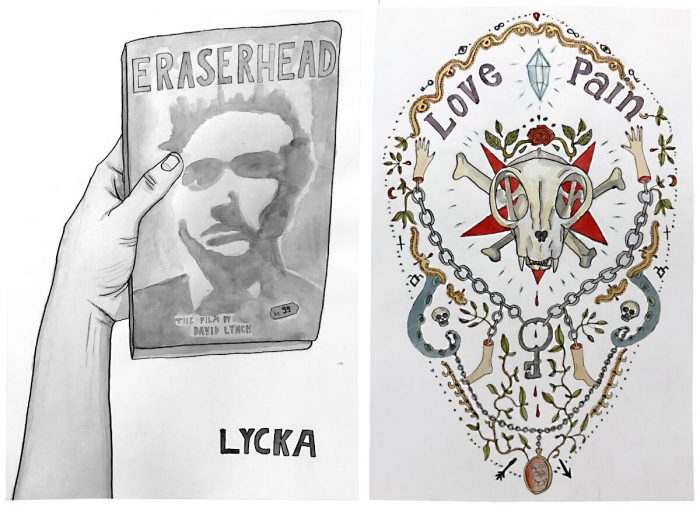
But back in the late ’90s, a few months after I got into Twin Peaks, I started to rent every David Lynch related VHS tape that I could find. I believe that Eraserhead was the first Lynch movie I got my hands on. I loved it. I know that I listed Eraserhead as being one of my favorite movies ever on my very first homepage, and that must have been in 1997.
25YL: How would you say Twin Peaks has inspired and/or influenced you and your art?
GF: First of all, the fact that I loved movies like Eraserhead and the general mysterious feel of Twin Peaks made me binge all other kinds of other movies that I found by accident or vigorous searching. I somehow got into early 20th century silent movies, Nosferatu, The Cabinet of Dr. Caligari, Un Chien Andalou, and Metropolis in particular. Earlier in life I had already established an interest for everything out of place, odd, unfit or strange, partly probably because that’s the way I saw myself in many ways. As young as five or six I felt a bit like an outsider—not necessarily in a purely negative way, but it was clear to me from a pretty early age that I was different somehow. On a bad day, different changed to “wrong”, but on a good day I was just fine with it. With the years this feeling of being somehow different became something that I made my own, reclaimed, if you will. I actively sought out the hidden or outspokenly ”odd” gems of art, movies, people, music, personal style, hobbies and interests.
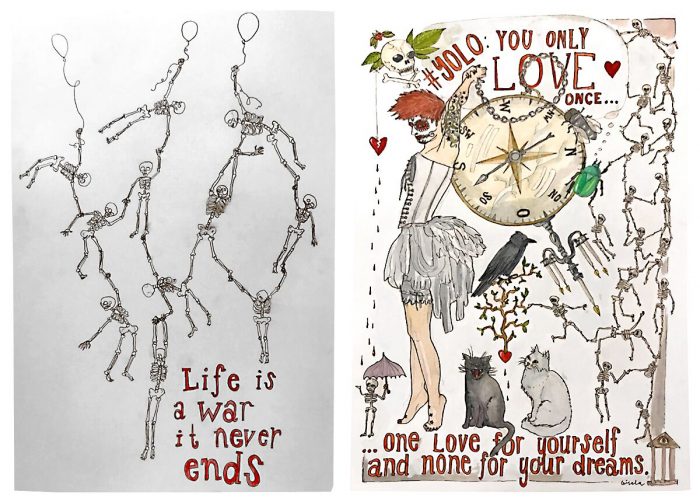
I’ve always been a very creative person with a real, almost physical need to express myself or just explore materials with my hands. Since I was first able to grasp a pencil with my hand I was drawing. Creating is somewhat of a first language for me. Just as anyone else, I saw and heard things by pure chance all the time, and I hand-picked some of it and made myself a metaphorical museum of personal preferences. I took to them, kept them close to me, and made them starting points for further investigations. I did so with my art, too. Twin Peaks was one of these things that I took to, but even throughout my childhood I had unconsciously started to build this collection of oddities that spoke to me. A museum exhibition of medical specimens, jars of siamese twins in formaldehyde. A TV program about the dead people found at Pompeii. A book about paranormal photography with one picture of a ghost that kept me up at night. The history of freak shows, the people who worked them, and the way we look at the Other and the one’s who’re different. Pictures of deep sea creatures that scared me in a way that it turned to curiosity. My beloved cat that died in a car accident when I was 14, and the terrible insight that death is just around the corner that followed. Medieval skeletons at another museum. The dynamics of the schoolyard and the feeling that life is better for some, and really bad for others. I think I took regular deep dives into rabbit holes that I either sought out or just stumbled upon.
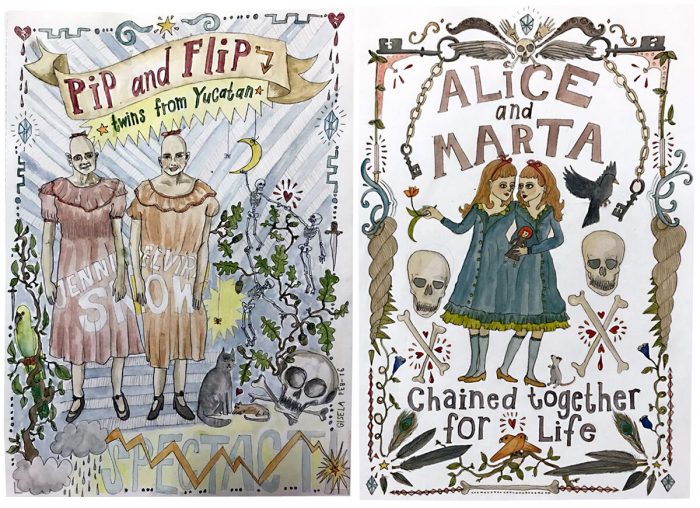
As strange as this might (or might not) seem, I often found that I had a strong urge to learn more, to know everything I could about the things that frightened me or made me sad or angry. Every time I found something to be scary, I always found myself fascinated and curious, too. With this came a real interest in the bizarre, odd, macabre, mysterious, expressionistic, surreal, and out of the norm. During my teenage years, the creative, the macabre, and the odd, all collided with the world of David Lynch and Twin Peaks. I see this today, thinking about the extraordinarily creative force that I started to explore when these meetings occurred. Back then I don’t think I could even see it happening. This mixture of my curiosity, creativity, the embracing of chance and my love for what most other people tended to see as ”strange” or out of the norm I think was very important for me—not only back then, and not only as an artist, but as a human being and throughout the rest of my life since then, too.

25YL: You started producing Twin Peaks reaction videos on YouTube during Season 3. How did that come about and what was the reaction from Twin Peaks fans like?
GF: I watched Parts 1-8 of The Return alone because every new part was released around 3 am on Monday mornings here in Sweden. Oddly enough, no one felt like coming over to watch The Return with me at that time…But that was OK. With every new part, it was like a holy ritual and a celebration. Somewhere around the very start of The Return I saw that there were some people making regular Youtube videos about each new part that came out. That’s when I first learned what a reaction video was. I had no idea that was a thing, but I found that I enjoyed watching some of them. I’m a very social, talkative and extrovert person, and the only thing I missed sometimes when watching The Return was someone to talk to about what was happening during watching and afterwards. But it wasn’t until Part 8 aired that I decided to start making my own reaction videos. I think you might guess why. Part 8 was like nothing else I’ve seen, and not only that: it was Twin Peaks—literally the one single thing in the world that I’m nerdy to the bones about. I really wished that I could have seen my own reactions when I saw Part 8.

So I decided that I would do a reaction video to Part 9 just to see how it felt. Just for fun, really. I didn’t prepare much, and I definitely wasn’t used to doing something like it, but I wasn’t too worried. I had no expectations. I didn’t think that people would even find the video, let alone watch it, but a couple of hundred people did. A few didn’t seem to like me at all, I’m not really sure why, but I’m completely fine with it. Most people did, however, and some even begged me to continue. I thought about it, and decided to do at least one more. And I did find it quite enjoyable, but the time of day was an issue for me. I had to decide whether to stay up until 4:15 or so, then sleep a little before work, or if I simply tried to go to bed around 8-9 pm on Sunday night to get some sleep before the new part was released at 3 am, then record myself watching it, do a little editing, go to work and continuing editing after work. It was a wee bit inconvenient, and for me, waiting until after work to watch brand new Twin Peaks material was just not an option. Fortunately, most of the parts were released during my vacation, and for the two part finale I simply took the day off.
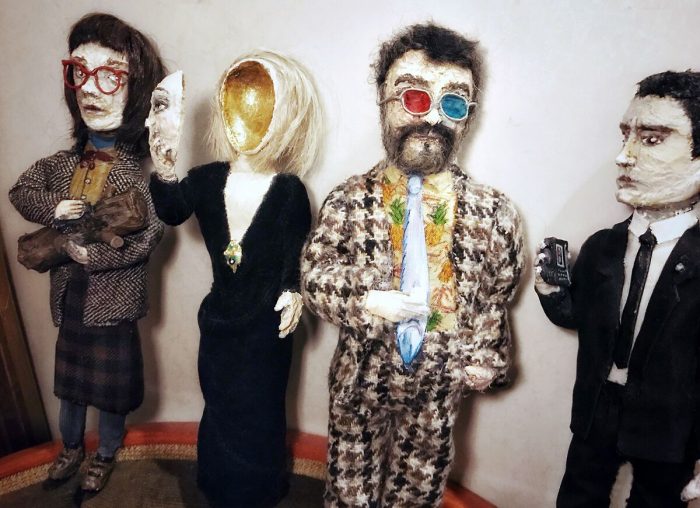
Somewhat to my surprise, more and more people started to watch my reaction videos all the time until the end. My reaction video to Part 16 has currently been viewed more than 24,800 times, which for me is just crazy. I think a lot of people wanted to share their own feelings about seeing Agent Cooper finally waking up, and also take part in others’ reactions to the same event. My goal was never to be a Twin Peaks YouTuber, so naturally, I stopped making videos after The Return had ended. Instead I focused on writing even more for 25 Years Later, where I had started writing in June 2017. Only recently, late this summer, I returned to my Twin Peaks YouTube subscribers with a video about connections (in audio but also visually) between Fire Walk With Me and The Return.
Not long ago, I also made an ”Ask Gisela about Twin Peaks” special (where, I have to say, I got some real challenging, fun and interesting questions from the viewers) and a video where I put together all of the funniest scenes from Season One. It seems like it’s appreciated, and it’s also a good way for me to create material about my nerdiest little hobby ever. It’s fun, interesting for me, and it really feeds my curiosity—just like writing about Twin Peaks is. So I think that I’ll continue to make videos when I’ve got the time.

25YL: Your project “365 Masquerades — Every day is a masquerade” sees you transform into a different persona every day for a year. Can you tell me about the origins of that project?
GF: The idea to transform myself into a different character every day for a whole year kind of came to me suddenly, but not out of nowhere. It was the evening of December 26, 2013. I got the idea while in a state of boredom, feeling perhaps that I needed ”something” to do, and do for a long time. Some kind of artistic challenge. A channel to express something, maybe, and definitely something that would be a playful, creative and close to my skills and interests. At the same time, I think I needed something to push me just a little bit outside of my own comfort zone. And there it was, this idea. 45 minutes later I had registered the domain 365masquerades.com, created social media profiles and written an initial text about what I was going to do. I guess it’s only fair to say that I’m a process oriented artist with a pretty high level of spontaneousness. But I never changed my mind. Six days later, on January 1st, I started my 365 days of masquerading. On the project’s web page I describe 365 Masquerades like this:
”As long as I can remember I’ve been drawn to masquerading, the theatre, performativity, dressing up (or down), playing with my own visual identity, creating costumes, daring myself to be “someone else” and to all kinds of different historical eras of fashion[…] Every day in 2014 I dressed up & down/transformed myself/performed a role/created a look/became a stereotype/looked like something.
I did it mainly to challenge myself and to be creative, every day, on my one-year journey of visual metamorphosis.”
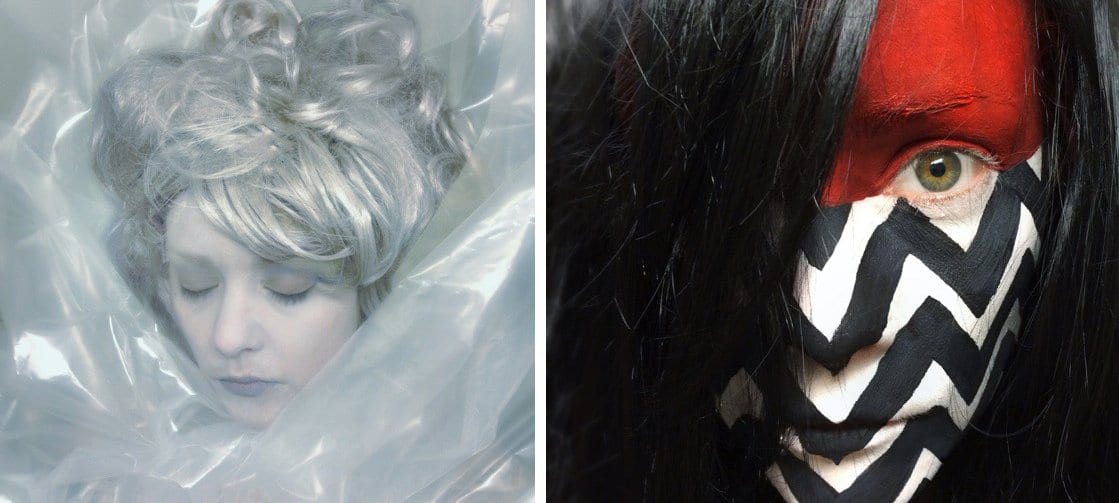
25YL: I had to look up what ‘performativity’ means, and now I’m going to use it constantly! Can you tell me a little about the process of and maybe how your feelings about the project changed during the year? What kind of reaction did you get?
GF: Looking back on all of the pictures, I think I can see that I got better during the year, both with the creating of the characters and with the process of capturing them/myself on picture. Most of them are self-portraits, simply because I was by myself probably in 85% of the case, and to take the pictures could be really challenging sometimes. Sometimes I had guests performing with me in character, that was fun too. I tried to vary my expressions and characters as much as I could. Men, women, children, animals, concepts, paraphrases, real-life celebrities, historical events, lots of stereotypes, a color, a historical era, an album cover or a painting, mythological or religious figures, and so on. I used make up, clothes, masks, wigs, everyday objects, scenography, anything I could find at home, really. For me, it was the process of transforming myself into the characters that was the best part. I hardly ever planned what I was gonna be. I had a lot of ideas, but many times I started working on myself without knowing where I was going to end up.
During the project it grew on social media, especially on Instagram, where I went from a few hundred people to almost 10,000 at most. Something that I found interesting was that many people asked me about how I had the time to do it, how many people helped that me out with my makeup or clothes, where I got all of the ideas, and similar questions. It surprised me how surprised they were every time I answered that I worked full time, that I did everything by myself (almost all of the days) and that I had more ideas than I would have days left of the 365 in total. I think I learned a lot about myself during 2014—and of other people, too. The things I love to do, and that come very naturally to me, would be a real challenge for many others. And, on the other hand, the things that most people take for granted, like an effortless ability to sleep a whole night, to be organized in everyday tasks, to have and be able to keep up good routines, to plan before you go all in to experiment—those are abilities that I’ve never really had in life, ever. Our brains work in different ways, and that’s fascinating, but it’s also a real struggle sometimes. Especially for the ones who’s brains work in ways that differentiates from what society, work, school or just people in general expects from you.
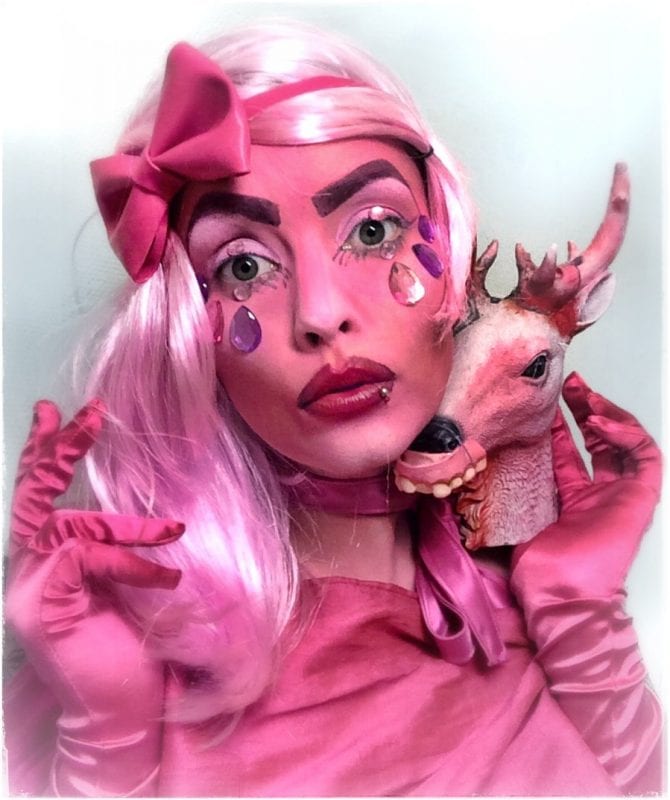
During my 365 days of masquerading I was evaluated and diagnosed with ADHD. It was a few months of process that was really confusing and mentally tough for someone like me, who’ve apparently gone through life with a feeling of being out of place, weird and odd. Suddenly I knew many of the reasons why I had carried that feeling for almost 30 years. To know was a relief, but it also made me sad and frustrated because I knew that I’d probably struggled twice as hard as others to fit in, and make it through school (with good grades, too) and to continue up to a university degree in art history without the help or support—or the self knowledge—that I could have had, had I been diagnosed earlier in life. The fact that I had 365 Masquerades during this interesting time in my life was a lifesaver in many ways. It also became, for me, a symbol of every artistic strength, skill and creative idea that I knew for a fact that I had, and I think I started to appreciate them more.
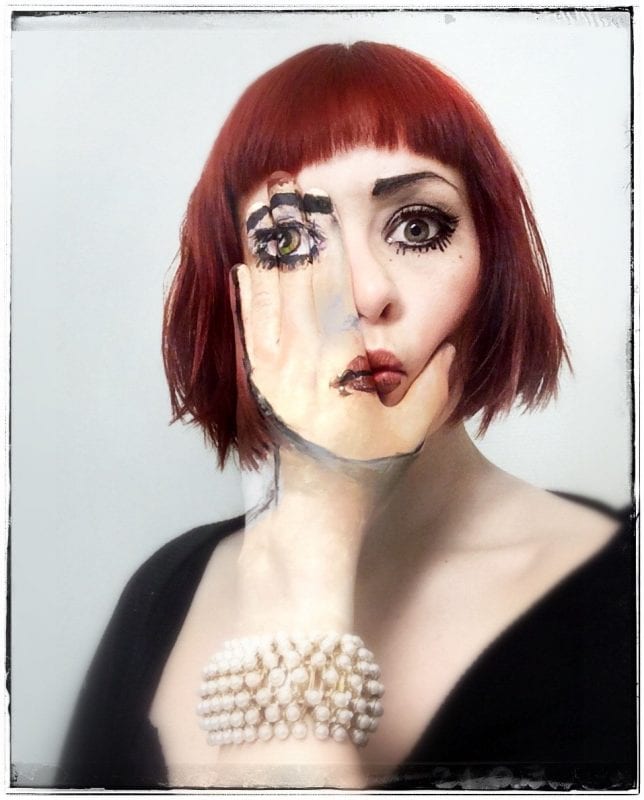
After the year, and thus the project, was over, I turned it into a self-published art book. It also became an art exhibition at a gallery in my home town, where I exhibited photographic C-prints alongside with many of the original masks and costumes that I had made for the project. I did a live performance starring (myself as) three stereotypical types of men that I called The Professor, The Feminist Dude and The Slob, and I let ”them” give a guided tour of the exhibition. This was a lot of fun since I work as an art educator myself, and I let these men that I played mix their own ways of seeing my art with myself in that way.
25YL: You’ve also been producing your own music for quite a while now. Tell us a little about that, and what it is that inspires and drives you?
GF: For me, music is another way of expressing myself. Many years ago, when I was 14, I started a band together with three other girls the same age as me. We had a lot of attitude, but we were also very playful, ironic and just good friends doing things together. In our case, we had this band. Two of the others actually wanted to play the bass, but eventually one of them learned to play the guitar instead. We didn’t care about being on sync, being technically skilled musicians or sounding great. We had fun. But we were also outspoken feminists, and we had no problem using our sense of humor to point out unequal structures that we could see around us by making fun of them. We called ourselves (translated from Swedish) Healthy Cellulites. I don’t even think we really knew what cellulites were, but we knew that it was something that women weren’t “supposed” to have, and I guess that was enough for us to use it. As you might have guessed, we had a real punky attitude to our songs, but we were also very influenced by indie pop, obscure Swedish left-wing bands from the 1970s, and bands such as Hole. We existed as a band for only a few years, but during those years, we performed live a lot and released two demo cassettes.
This musical chapter in my life was not the first, nor the last. As a child, I actually played the violin for eight years. Later, after the punk pop chaos band years, I went solo. I’ve been making music ever since, but sporadically. Since 2001 I’ve been self-releasing my music online under my first name Gisela. Back then, I had a very different sound than I have now. I also have a different way of creating my music today. The creative process I prefer nowadays is quite similar to the process focused way that I work with visual art. My songs might start off with a simple combination of guitar chords that I record before I know what will come, if anything. Actually, the way I tend to create my music in later years reminds me a lot of what I described before about sometimes starting to put makeup or clothes on before I knew where I’d end up during 365 Masquerades. Sometimes I use different clips of my recordings to make a collage-like patch that ends up being a song that I can start to see looming. Sometimes I’ve simply grabbed the guitar, pressed Record and started improvising. One of my own favorite songs, “No heart, no soul” was made this way. I improvised on the guitar, it was summer, and the door to the balcony was open. It was raining outside, and the sound of the rain made it into the recording, which is something that I like very much. I usually embrace the chance whenever it intervenes. I forgot about the recording I’d made, and when I found it on the computer again more than a year had passed. When I listened to it again, a song appeared, and the lyrics that didn’t exist before just fell into place.
I like to sometimes add samples and/or ambient recordings to my songs to create a kind of ”raw” or ”dirty” feeling to them. I have a tendency to buy musical instruments at flea market—instruments that I have no traditional skill or knowledge of how to play, but I see that as a part of my experimental and creative approach to art in general. Last year, I bought a banjo. I don’t know how to play the banjo. But what will happen if I use the violin’s bow on the banjo? What happens if I combine that, whatever it will be, with the different sounds that I can create with my old zither? And then, let’s add two or three chorus lines…This is the way I tend to build my songs, layer by layer, sound by sound. It’s done without much planning ahead, but it’s also without any stress or concerns about the final result. It’s a process. I’ve found that it’s often the case that whenever I completely let go of thinking about a result, whenever I focus on the process instead, I actually end up liking the result.
25YL: Has Twin Peaks and Lynch inspired or influenced your music?
GF: I’d like to be able to lay out exactly how Twin Peaks and David Lynch as an artist have influenced my music or visual art, but I find it impossible to pinpoint. I know for a fact that it’s there somewhere. Inspiration, however, is too abstract to substantiate and thus it cannot really be accounted for. But I know this: When I saw David Lynch’s The Art Life for the first time, I felt many different things at once. My nerdy side was there, of course, but it eventually ended up being completely overshadowed by feelings of recognition, interest, and a humbling sense of familiarity. Not only do I work professionally with art, creative processes and people, I’m also an artist and I have a degree in art history. My main interest in art is the processes and the social aspects of art. As everybody else, I knew that Lynch started off as a painter, and that he ”wanted to see the paintings move”, but I really hadn’t had the opportunity to see his art in real life. Seeing objects in front of you is very different from seeing them online or in a book.
But in 2010 I had the pleasure of visiting Lynch’s art exhibition The Air Is On Fire in Copenhagen. Seeing his paintings, I sensed a feeling of playfulness. Between a dirty old pair of jeans what were stuck to the canvas and the seemingly unidentifiable goo that made up the figure’s facial features, I thought I sensed an artistic process that wasn’t necessarily planned out in detail before it began. Rather, the paintings felt like they were created with a process oriented mindset. There was an experimental journey towards whatever might be. Later, watching The Art Life, I thought that what I had sensed at the exhibition might not have been too far off. Watching Lynch being inside his own artistic process made me think about connections. I’ve been admiring his work since I was a teenager, a time in my life when I started to explore my own abilities, embracing chance and developing my own creative work processes. Looking back, I find it possible that I’ve been influenced or inspired by the realms of Twin Peaks and David Lynch for a long time, either subconsciously or in ways that cannot be easily identified.
25YL: Do you have any plans in the near future for your various artistic endeavours?
GF: For many reasons, I’m not planning very far ahead at the moment. I’ve had that kind of year that makes you need and want to take one step at a time with just about everything in life for me. In the next month or so, I might make another video on Twin Peaks, write a new song, write a new article, draw, or build a diorama. I might do none of it or all. If it was up to me alone, I’d do all of it and more. What I’ve got planned this fall so far has more to do with creative processes and art education, which is what I do for a living. Among other things, I’ll continue my art workshops for adults where the focus is for each attendant to explore their own creativity in a process-oriented way. Even though my function during this is more of a Cicerone to other people’s creativity, it’s still very creative for me, too, although in a slightly different way. My hopes and believes this fall are that I’ll fill my world with my own projects as well, whatever they will turn up to be.
25YL: Hopefully not too long before we get another symbol-laden deep dive from you here on 25 Years Later! Its’ been great to talk with you Gisela. Thanks!
You can catch up with the art life of Gisela on Instagram @365masquerades and @dadawundersociety, visit her website, and on YouTube watch her Twin Peaks videos and listen to her music, and read all her articles here on the site. All artwork displayed with permission, please do not reproduce without permission.



